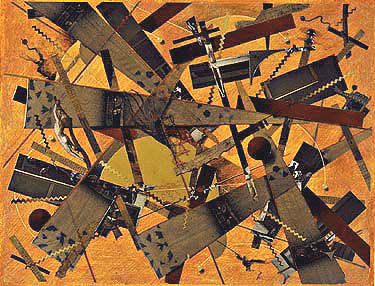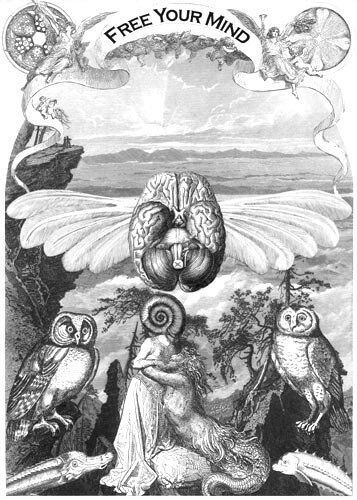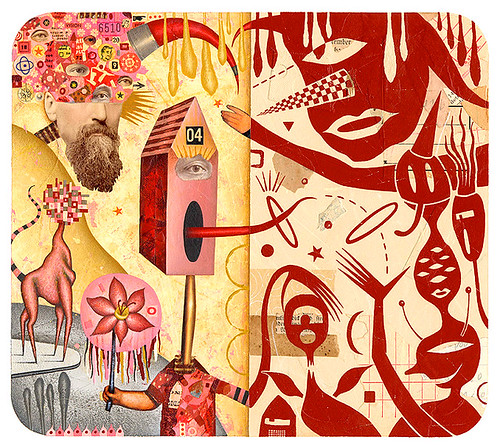This is a cut and paste of a report that you can find
here. I wanted to cut and paste it because sometimes I worry about things on the net disappearing. I want to be able to read this again for certain.
"Ray Johnson, like most any other artist, has been the subject of varied and varying critical opinion. Presented here will be an Informal review of my comments on those critical reviews of Ray Johnson and the art of Ray Johnson. It will be a literary college of opinion and commentary from which (I hope) will emerge a coherent view of Johnson and his work.
In the forties and fifties, Ray Johnson was trained as a painter. He knew people who were "in" and some who were bound to become "in." Some time in the fifties, he began composing his collages. Among the better-remembered pieces are his "Elvis Presley No. 1," "Elvis Presley No. 2," and his "Moticos." The two Presley collages, which were done in 1955, mark for some critics a forecasting, a foretelling, of Pop Arts
... Ray Johnson's manipulation of the Presley portrait was something new; it went beyond the use of ideas from photography to merge the very materials of camera work and paint. The photographic image contributed to a sense of actuality--After all, the camera does not lie--and the use of that image was a harbinger of a new realism that was to mark painting. The new wave was born of Pop Art, that deadpan, sarcastic movement that had its prophet in Johnson and its father in Andy Warhol. [1]
These collages, which he called "moticos," also played a part in the evolution of his style. Until the early sixties "he never exhibited in galleries or museums but would only show his work in places llke Grand Central Station or the street [see Fig. 1]. The random arrangment of 'moticos' (a self - invented name for his collages which he stored in cardboard boxes, often cutting them up again later to make new ones) on a dilapidated cellar door In lower Manhattan may even have been the first informal 'Happening'.[2]" These were the beginnings of what Ray Johnson has become noted for: collage in many forms.
The formal collage is the medium for the Ray Johnson who shows with the formal gallery. Although in the early sixties he did perform/conduct a few "nothings," (which amounted to anti-happenings), the majority of his gallery shows were collage. The collages of Ray Johnson are without a doubt provocative material.
"Q. It seems to me that collage as a medium lends itself to the expression of satire and social commentary.... Doesn't it take a lot of 'tasteful' selection to add up to pictorial creation?
Johnson: I would suggest your question be presented to Vera, who might supply an interesting answer. Sorry to pass the buck."[3]
David Burden's article of 1964 publicly set the stage to what had already been happening for Ray Johnson for a long time. The element of humor in the collages, whether projected through satire, pun, visually or verbally in Ray Johnson's most formally damning and most informally constructive element. Structurally, his collages are "very accomplished, finished, framed in wood and glass, no loose ends."[4] and "look like elegant enough examples of the assemblage esthetic."[5] The content is where Ray Johnson takes off, often leaving the unknowing viewer behind. One early reviewer complains, "The artist explains every fragment by a tangle of literary references to current events, private lives, and predominantly a running dialogue with the art world, mostly in the manner of the verbal quibbles of Rose Sélavy; so that each work is meant to be read like a rebus. Unfortunatelyt the key is not to be found without the artist's personal assistance, and is certainly not embodied in the works themselves...."[6] Yet, another critic will proclaim, "Ray Johnson Is a poet-painter. To what extent collage is close to poetry, collage gets like literature in that it must be read, scrutinized; collage is small on/with paper."[7]
The fact is that Johnson's collages have primarily dealt with "biographical references to himself and his artist friends."[8] His collages are verbal and visual "bits of in-formation, puns, associations, and moments of intense attention."[9] The problem is that unless you are Ray Johnson or you are within the bounds of his artistic circles, most of the content is unappreciated. It is apparent that most of the jokes can only be appreciated by a select few. Like the jester in the courts of old, Ray Johnson has taken the kings and queens of the New York high life and made them at once the brunt and the subjects of his humor.
"Johnson disarmingly admits that his art is at best minor but his subject material may not be. Itts a bit like a still-life painter who manages to tell us more about history than a big history painter. Very good minor work makes a lot of serious work look a little strained--which may mean no more than that minor work is informal and most major work is formal and vulnerable. Our best minor artistsg however--and I use this here In the nonpejorative way one refers to good minor poets--are thus our best critics. Johnson exercises humor rather than wit, wryness rather than epigram: he collects New York artists like stamps; that is, with-out irony. In other words, he likes his subject matter, and could no more function outside the New York scene, to which he inescapably belongs than Cezanne could do without apples."[10]
This is, perhaps, a good overall commentary on the collages of Ray Johnson but It is quite nearsighted when applied to his work in the realm of correspondence art. While Johnson's collages assume a highly specialized audience/ referent, his correspondence art does not limit appeal to such a small coterie. In short, it is specialized but not limited. Further, as I've said, Johnson's collage art is the stuff of his gallery/museum exhibits. The correspondence art does away with the need for gallery or museum to display a "completed" art. Rather, the correspondence art is the process of art--and the end result is art.
Ray Johnson is by no means a newcomer to the area of correspondence or mail art. A recent retrospective of his epistolary works includes letters from the forties, postcard collages from the early to mid fifties, and, of course, the volume of work that grew along with the New York Correspondence School (NYCS), during the sixties and seventies. It is through the auspices of the NYCS that Ray Johnson has been able to carry out his wildest dreams as far as one can see. (His imaginative capacity is difficult to measure.)
One of the primary purposes of the NYCS is, as one observer has noted, "the idea that art should be a wholly non-commercial and intimate experience among friends. The conventional museum/gallery assumptions about art are laid aside and the communication process itself is the member's primary concern."[11] This reflects Johnson's earlier pre-sentations of his collage "moticos" in the streets of New York. That is, the NYCS gave Ray Johnson a tool to expand the communication process; more widely, in the form of mailings. These included personal letters to specific individuals [see Fig. 2], xeroxed copies of form letters and bulletins that carried specific messages to certain NYCS members [Fig. 3]; and general bulletins [Fig. 4]. He would often compound the process by creating a revolving exchange. In other words, an item would be sent to person A, who would be asked to add or to delete something and then to send it to person B, who In turn would send it on to D, E, or F, or maybe back to Johnson; so the process would be a continual, renewing cycle. Invariably, Johnson would, after a while, come to know something personal about the member to whom he was communicating. The dominant idea is reference to personal references. Once again, the possibility of the private joke comes up. But this time the joke Is shared with a broad spectrum of individuals who "belong to" the NYCS, who then spread It even further to their respective circles of friends. Basically, It is a very open-ended form of art.
As an example of this process, Marcia Tucker, then Curator at the Whitney Museum, received a deluge of mail art from the members of the NYCS; this resulted in a semi-formal showing (1970) shared with the "public." And once again the critics sat on both sides of the fence. Comments ranged from "It's an image-word ragout that's best enjoyed and not analyzed"[12] to "all of them (the show entries) are missing the mark as far as wit goes because there was some ingrained, indiscriminate nastiness behind them, a barely repressed venom to which true wit or true art are never in service."[13]
Another by-product of the mailings of the NYCS are the meetings. These meetings, which are announced through Ray Johnson's mailing lists and sometimes in local press, may or may not actually take place. While the majority of them were planned and executed in New York, others have been in Kansas City; Oberlin College, Ohio; Chicago; Baltimore; Raleigh, N.C.; and California. The meetings create another channel of communication: direct interaction. They give people a chance to meet and know one another better. Ray Johnson, as in the mail correspondence, is once again the perpetrator and the mediator. He controls the group in only the most minimal way. It has been said that he is more interested in observing the results than in controlling them.
Observing all of this may appear to be off the track of Ray Johnson's correspondence career and even further from the collage motif. But It all relates, In a typical Johnsonian fashion. The mailings, the NYCS, the NYCS meetings and the formal collages are all part of an overall system, an ongoing process of reference and cross reference. The system is communication. Ray Johnson uses communication to form an immense collage of material, idea, and people. The big collage is Ray Johnson's art.
Humor and games are the basic elements of the big collage. Humor is always present, whether in the form of verbal and visual puns or people enjoying activities outlined for the NYCS meetings. This Is all part of a general quality: word games, parlor games, mind games. Ray Johnson is very much the prankster, the trickster, and the jester. These factors--the games, humor, involvement--have contributed to many peoples' pigeonholing Ray Johnson into the Dada ethic. He has been referred to as "the Dada Daddy of mail art art mail ... mainstream from Marcel Duchamp."[l4] Clearly, there is a connection with the Dada movement and a certain fascination with Marcel Duchamp. But to think that Johnson is totally a Dada or neo-Dada is quite incorrect. One must also consider the Surrealists.
Granted, when one considers Individual works by Ray Johnson, each may appear Dada-like. They may make comments about the subject in a negative fashion, apropos of the Dada mind. But, in the overall scheme of things, the value is a positive one. Johnson is building a system. The system is based on unified correspondences among many components. He is not trying to destroy anything although it may appear that way because he works outside of the normal realm of art. Contrary to the Dadast Johnson does not attack "art"; he usually focuses upon the individual artist Instead. His attack is not with malicious intent to do harm but is more a teasing to bring about a mental blush. Blushing causes an increased circulation as the result of stimulation. Increased circulation brings fresh blood to the surface. Johnson may, in fact, be aiding new blood to come to the surface. This is a positive attribute and an idealistic quality, much as the Surrealists were positive idealists. More concretely, Johnson's favourite games are those of the Surrealists.
The best-known of these Surrealist games is "the Exquisite Corpse." This is a simple game in which the first person would draw one part of a body on a piece of paper and then fold it; the second person takes this paper, draws another part of the body, then folds the paper again; each player takes and draws, not being able to see the previous drawing. The result is unfolded and a usually illogical figure is revealed.
Johnson took this process and adapted it to his mail art (as previously mentioned in this paper). He also used verbal adaptations of the game during the NYCS meetings. Through his use of games and his gentle humor, Ray Johnson better fits the mold of the Surrealist than that of the Dada. But Johnson's answer to this categorization is: "I would not be a collagist, I would not be a Surrealist, I am a Sandpaperer."[15] Sandpaperer or not, Johnson's humor avoids negation, relying on the essentially positive nature of the true comic perspective.
This has been a rather rapidly-paced examination of the art and style of Ray Johnson. But there is not any one chronicler in the past who has gone even this far. Articles discussing Ray Johnson usually involve only one facet of his art as life as art. If for no other reason than a beginning, this paper has served its purpose for me. The early years of Ray Johnson are an incredible enigma wrapped up in a myth constructed by him. There is little known or said to the public about where the man came from. That is a topic worth investigation. A comparison of the early to late collages is also a possible topic for research. Unfortunatelyg one discovers that Johnson takes his old pieces that have not sold, cuts them up, and makes new pieces out of them. (Not a bad idea, actually.) And there is the New York Correspondence School--but which aspect? The membership list? The content of the mailings? The value of the art as correspondence? Or, what about the NYCS meetings? Just exactly what was Ray Johnson's role in the whole affairs from an analytical point of view?
The topics listed above cover only concrete material and events. What about the more abstract topics, such as humor, games, and philosophical and aesthetic pigeonholes? There are books and books written about humor in the literary world, but where are those for the art world? Johnson's art and attitudes would. make material for at least a chapter or two. Too, games seem to be popular with psychologists these days. That would. lead naturally to an indepth study of the significance of the encounter situations created by Ray Johnson. The psychological study would in turn lead us almost directly to the sociologists and the linguists. The sociological study could probe Ray Johnson as a popular artist. The linguist could show a logical progression from the earlier correspondences to those of the present day (after a sufficient amount of time spent finding all those older pieces). Ray Johnson is a new form of popular artist--what of the other popular culture apects he has promulgated? Mail art as a form of mass communication in an Impersonal world? The New York Correspondence School and its meetings--a revival of the New England town meeting? Perhaps by speaking in historical modes, we could attempt to analyze and label Ray Johnson.
But it was not the purpose of this paper to label Ray Johnson, to put him into any one particular pigeonhole. It was my intent to introduce Ray Johnson--his basic ideas, the basic elements of his art. As the list of topics above shows, I am still exploring. At the present time, I can only conclude that Ray Johnson is the Big Collage."























